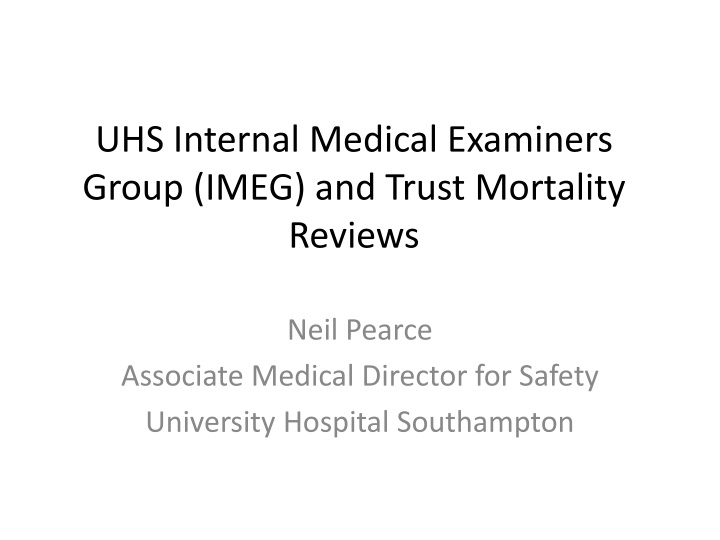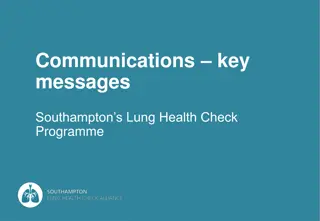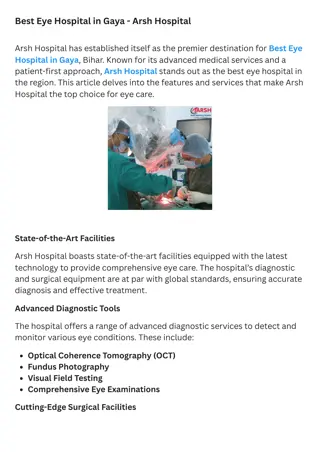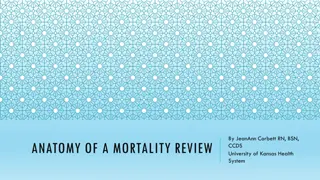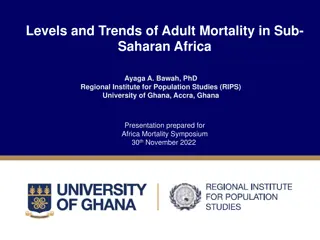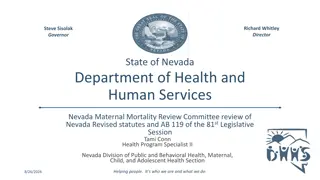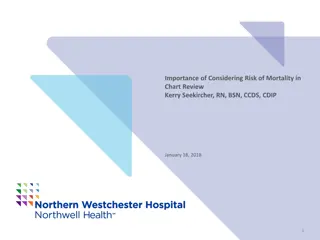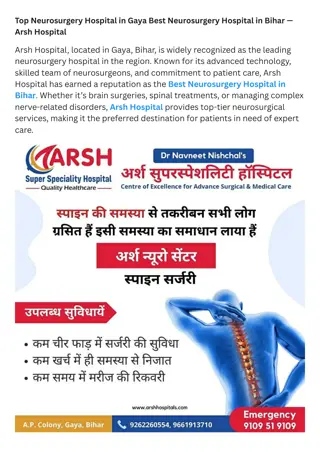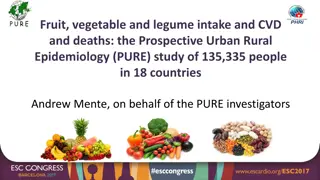University Hospital Southampton IMEG Mortality Reviews Overview
University Hospital Southampton's Internal Medical Examiners Group (IMEG) oversees all death certification processes, inquest referrals, and reviews to ensure high standards of care and identify potentially avoidable deaths. The IMEG's terms of reference include independent scrutiny of inpatient deaths, assessment of end-of-life care, and early identification of family concerns. The IMEG's mortality review process involves evaluating care standards, identifying clinical concerns, and taking action based on avoidability ratings.
Uploaded on Sep 29, 2024 | 1 Views
Download Presentation

Please find below an Image/Link to download the presentation.
The content on the website is provided AS IS for your information and personal use only. It may not be sold, licensed, or shared on other websites without obtaining consent from the author.If you encounter any issues during the download, it is possible that the publisher has removed the file from their server.
You are allowed to download the files provided on this website for personal or commercial use, subject to the condition that they are used lawfully. All files are the property of their respective owners.
The content on the website is provided AS IS for your information and personal use only. It may not be sold, licensed, or shared on other websites without obtaining consent from the author.
E N D
Presentation Transcript
UHS Internal Medical Examiners Group (IMEG) and Trust Mortality Reviews Neil Pearce Associate Medical Director for Safety University Hospital Southampton
Maternal and Perinatal Death Child Death and Deterioration IMEG All adult inpatient deaths 30 Day Post Discharge Deaths ED and Major Trauma Centre Mortality
IMEG oversees all death certification Inquest Referral to HMC Coroner s PM Part B Death on Ward IMEG Panel Review Death Registration Part A Approved MCCD Bereavement Meeting Concerns Raised Internal Review / Investigation (see next flowchart)
UHS IMEG/Mortality Review Flowchart Speciality M&M No adverse event but potential learning No Care Concerns No Further Action IMEG REVIEW (with directed questions) TMRG (structured case note review) Scoping Meeting Potential serious adverse event / avoidable death Care appears to be below expectations Avoidability Rating 1, 2, or 3 Action: Root Cause Analysis and action plan Avoidability Rating Avoidability Rating Avoidability Rating 4, 5, or 6 Action: feedback to clinicians, discussion at M&M Avoidability Rating 1. Definitely avoidable 2. Strong evidence of avoidability 3. Probably avoidable (more than 50:50) 4. Possibly avoidable, but not likely (< 50:50) 5. Slight evidence of avoidability 6. Definitely not avoidable
IMEG Terms of Reference The hot review of every adult inpatient death Independent internal scrutiny by senior clinicians Discussion with a member of the team prior to death certification or referral to the coroner To assess the standard of care, Review end-of-life care To identify clinical concerns and adverse events To identify potentially avoidable deaths To improve the quality of death certification and reporting to HMC Early identification of family concerns
LD and mental health reviews
Serious Adverse Event Case Review Meeting: Trust Mortality Review Group (structured case note review) Identified areas of clinical concern which are thought to have directly contributed to death or other severe/ catastrophic harm Any case where there is not a clear serious adverse event but the reviewer has concerns that care could have been better and potentially ,may have adversely affected the outcome IMEG Morbidity and Mortality: Family Concerns: Bereavement care and patient support services Where elements of clinic care are felt may have been below normal expected standards, but which are unlikely to have contributed to death. Also highlight valuable learning and favourable events. Contact will be made with the family, usually directly through the bereavement care meeting, and a decision will be made with them about how best to resolve their concerns.
Serious Adverse Event Case Review Meeting: Trust Mortality Review Group (structured case note review) Identified areas of clinical concern which are thought to have directly contributed to death or other severe/ catastrophic harm Any case where there is not a clear serious adverse event but the reviewer has concerns that care could have been better and potentially ,may have adversely affected the outcome IMEG Morbidity and Mortality: Family Concerns: Bereavement care and patient support services Where elements of clinic care are felt may have been below normal expected standards, but which are unlikely to have contributed to death. Also highlight valuable learning and favourable events. Contact will be made with the family, usually directly through the bereavement care meeting, and a decision will be made with them about how best to resolve their concerns.
Serious Adverse Event Case Review Meeting: Trust Mortality Review Group (structured case note review) Identified areas of clinical concern which are thought to have directly contributed to death or other severe/ catastrophic harm Any case where there is not a clear serious adverse event but the reviewer has concerns that care could have been better and potentially ,may have adversely affected the outcome IMEG Morbidity and Mortality: Family Concerns: Bereavement care and patient support services Where elements of clinic care are felt may have been below normal expected standards, but which are unlikely to have contributed to death. Also highlight valuable learning and favourable events. Contact will be made with the family, usually directly through the bereavement care meeting, and a decision will be made with them about how best to resolve their concerns.
95% Of Doctors Think IMEG is a Positive Learning Experience 80% 71% 70% 60% 52% 50% 44% 2015 40% 2016 30% 24% 20% 10% 5% 3% 1% 0% SA A N D SD Nil Response SA=Strongly agree, A = agree, N = neither agree nor disagree, D = disagree, SD= strongly disagree
91% Of Drs Find It A Good Opportunity To Reflect On Practice 50% 46% 45% 45% 42% 40% 35% 30% 26% 2015 25% 25% 2016 20% 15% 10% 7% 4% 5% 3% 2% 0% SA A N D SD Nil Response SA=Strongly agree, A = agree, N = neither agree nor disagree, D = disagree, SD= strongly disagree
68% of junior doctors changed their practice following IMEG discussion 45 40 35 30 25 20 Change in practice 15 10 5 0 Strongly agree Agree Neutral Disagree Strongly disagree
2016/2017 IMEG Deaths 2444 Total Deaths in UHS 225 Non IMEG* 2219 (91%) Reviewed in IMEG (32 +2 +19 +172) Reviewed outside IMEG** 1994 Certificates Issued 966 (39%) Referred to HM Coroner 225 (9%) Coroner s PM/Inquest *= ED Deaths (MTC), maternal deaths, stillbirths, neonatal, paediatric **= CDAD + Maternal + stillbirth/Intrapartum + ED / MTC
Maternal, Stillbirth and Intrapartium Death Child Death and Deterioration IMEG ED and Major Trauma Centre Mortality 30 Day Post Discharge Deaths The next big challenge!
2016/2017 IMEG Additional actions 60 (2.5%) Serious incident scoping Meeting 42 (1.9%) Incident Report 4 Falls Panel 13 VTE Panel 119 (4.9%) Total for adverse events 50 (2.2%) M & M / Clinical questions 68 (3.1%) TMRG Structured case notes review 237 (10.2%) Total additional actions
2016/2017 IMEG 8 Additional Serious Family Concerns identified 16 Learning disability case review End of Life Care 1793 (73%) DNACPR 908 (37%) Hospital Palliative Care Team 34 (1.5%) Hospital post mortem examination Medical Certificate to Cause of Death 1299 (53%) No Change / Clinical Decision 758 (31%) Minor Change / Joint 374 (15%) Significant Change / Reviewer Modified 9 (<1%) Change by HMC 2 (<1%) Cause of Death HMC
IMEG Conclusions Hot review of inpatient deaths, linked to a system of adverse event reporting and structured case notes review provides an effective means of assessing quality of care and avoidability Improves the quality of bereavement care meetings Facilitates discussion of end-of-life care Ensures early scrutiny of mortality in vulnerable patient groups IMEG has significant educational benefit for medical staff and changes practice
